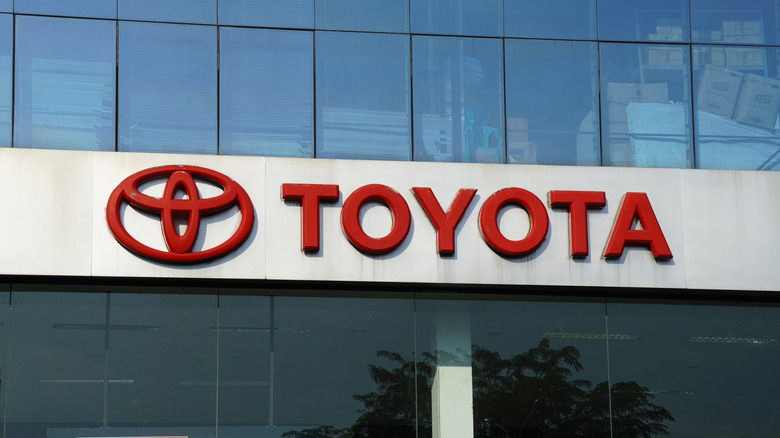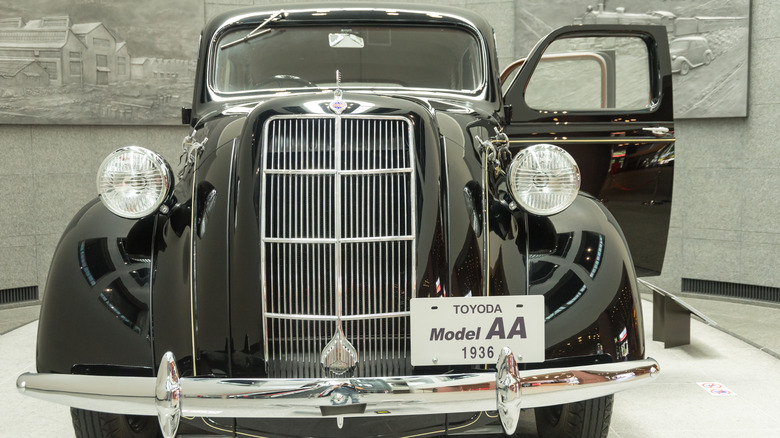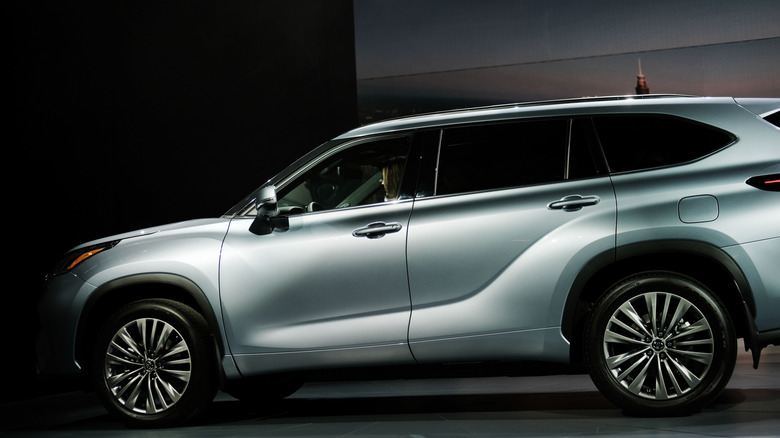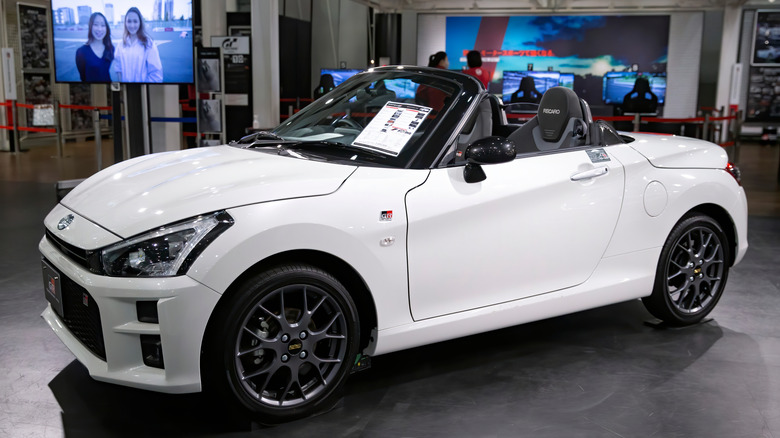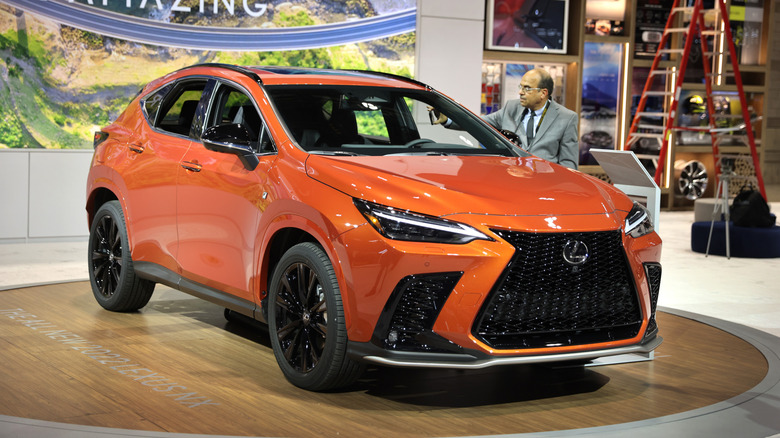Who Owns Toyota And Where Are Its Vehicles Built?
Toyota began as a company that focused around Sakichi Toyoda's invention of the automatic loom. Toyota's very first car, the venerable Model AA, was developed by Kiichiro Toyoda, when it was determined by the founder that the time was right to expand into the auto sector. Nagoya, Japan was the home of the loom works, and many years later, it became the home of the Toyota Commemorative Museum of Industry and Technology, which opened its doors in June of 1994.
Since its very first vehicle, then, Toyota has built its own cars, and went on to be owned by what became established as Toyota Motor Corps. It is not a subsidiary, but it does have them: Lexus, which was itself founded in 1989, is the arm of Toyota responsible for luxury vehicles, with beautiful models like the LX600 Ultra Luxury among its portfolio. Toyota Motor Corps also owned Scion, a label that tried to target a younger audience, but it didn't pan out and the Scion brand disappeared when the '16 model year wrapped up.
Toyota Motor Corps, technically, makes Lexus models as well as vehicles that were under the Scion name. Toyota, then, makes its own vehicles and isn't owned by an outside property, though it is part of the wider Toyota Group. To do so, it operates manufacturing plants and headquarters all around the world. Here's where Toyota's many facilities are located, and exactly which of the marque's models are produced in which countries and regions.
Toyota in the United States
Some acclaimed Toyota models are made in the U.S.A., including the formidable Grand Highlander and the ever-popular Toyota Corolla sedan. The former is built by Toyota Motor Manufacturing, Indiana, Inc., at its Princeton plant. Here, the Highlander, as well as the hybrid variant, the Sienna Hybrid, and Lexus' TX, are also built.
Over at Toyota Motor Manufacturing, Kentucky, Inc., engine building is a significant part of the plant's work, but it's also directly involved in the construction of several car models. These include the Camry and its Hybrid variant, in addition to the Lexus ES, the hybrid model of the same, and the RAV4.
The celebrated compact that is the Corolla is also built at some U.S. plants. Toyota Motor Manufacturing, Mississippi, Inc. has a factory in the Union County village of Blue Springs, and it has been the home of U.S. construction of the Corolla since the work began there in 2011. Meanwhile, the Corolla Cross and the hybrid Cross are built in the city of Huntsville in Alabama, at the facility of Mazda Toyota Manufacturing.
The last Toyota facility in the U.S. that actively builds its vehicles is located in Texas' San Antonio. It has been operational since 2006, and Toyota boasts that a new Sequoia hybrid or Tundra/Tundra hybrid is completed there every minute. Elsewhere in the country, facilities in Alabama, Missouri, West Virginia, and Tennessee make components for the vehicles, such as the all-important engines.
Toyota manufacturing in Japan
There are 16 different Toyota facilities in Japan, with the longest-serving being DAIHATSU MOTOR CO., LTD., a subsidiary that has been at work since 1907. It builds the adorably pocket-sized Pixis and Copen, the Roomy, Raize, and the charmingly no-frills Probox van. Daihatsu has four locations, with the Copen being produced at the Copen Factory in Ikeda, Osaka.
The Corolla, Corolla Cross and Corolla Touring are developed at the Takaoka Plant, as are the Harrier SUV and the RAV4 hybrid. The Corolla and Corolla Sport are also built at the brand's factory in Tsutsumi, where Biotope Tsutsumi opened in 2018. This plant also builds the Camry, Prius, and the Sport and Crossover variants of the Crown.
In December of 1992, Toyota Motor Kyushu, Inc., a plant in Fukuoka, opened. The Lexus NX, UX, and RX are now built here alongside the ES. Other Toyota plants in Japan include the Motomachi facility, which opened in 1959, and TOYOTA AUTO BODY CO., LTD., now building ambulances as well as ten other models including the Coaster minibus and the Lexus LX. This subsidiary has four facilities across Aichi, as well as one in Inabe and operations in Thailand, China, and more.
Vehicles of the Yaris and Corolla families are built by TOYOTA MOTOR EAST JAPAN, INC., as are the JPN TAXI, the Lexus LBX and the Toyota Sienta and Aqua. Another Tahara City plant constructs seven different Lexus models, plus the luxurious Toyota Century and the Land Cruiser 250.
Toyota's vehicle-building plants around the world
In the continent of North America more broadly, Toyota has a base in two other countries. Mexico boasts two facilities. Toyota Motor Manufacturing de Baja California is located, funnily enough, in Baja California, and Toyota Motor Manufacturing de Guanajuato is in Guanajuato. These are two newer properties in Toyota's repertoire, having kicked off production in 2004 and 2019 respectively. Both plants are dedicated to that trusty pickup, the Tacoma: The standard model is built in Baja California, while the Guanajuato facility also manufactures the hybrid Tacoma. In Canada, Ontario factories build the RAV4 families and Lexus NX.
Across the continent of Europe, France, the Czech Republic, Turkey, Portugal, and the United Kingdom all construct Toyota vehicles too. Toyota Caetano Portugal, the result of a 1968 deal with Salvador Caetano, manufactures the Land Cruiser at its facility in the city of Ovar. Its output has also included other models, like the Corona. In France, the Yaris is built at the plant in Valenciennes, while a facility in the village of Burnaston in the U.K. has built around five million Toyota vehicles since beginning operations in 1992.
The brand also had a plant in Russia that had developed the Camry and the versatile SUV they call the RAV4, but in September 2022, it was confirmed that it would stop building cars in the country. Toyota stated in a press release, "we have not been able to resume normal activities and see no indication that we can re-start in the future."
Further expansion from the global vehicle powerhouse
For a lot of the biggest companies, the claim to have 'taken over the world' isn't really much of an overstatement. Toyota, for instance, boasted in a March 2012 press release that a trio of specially-adapted Hilux achieved a new world record for the length of an Antarctic expedition, a journey of an astonishing 28,500 km all together. Toyota may not build cars in Antarctica (it probably would if it could), but it's no surprise at all to learn that there are still more locations that build its vehicles.
In South America, Venezuela and Argentina build the Hilux and the Fortuner, with the former also manufacturing the Corolla with its factory in Sucre. Brazil has a Toyota facility in Sao Paulo, and the nation develops the Yaris and vehicles in the Corolla line.
Three African countries also build Toyota vehicles, with Toyota announcing the beginning of Fortuner assembling in Egypt in 2012. On the continent more broadly, Kenya produces the Land Cruiser, while Toyota South Africa Motors builds the Fortuner, Hilux, and Corolla, as well as the Dyna commercial truck and some models from Hino.
Several countries across Asia also produce Toyotas. Prominent among them are factories in Bidadi, India, and the Ban Pho, Samrong, and Gateway plants in Thailand. Between them, the trio of Taiwanese plants build the C-HR, Corolla and Yaris families, the Fortuner, the Hilux, and Camry.
